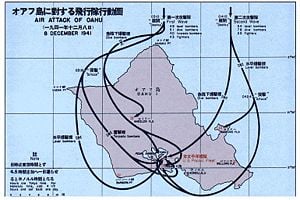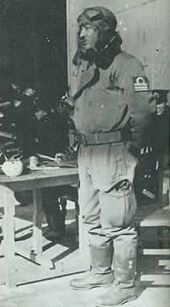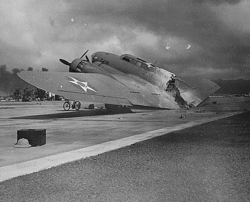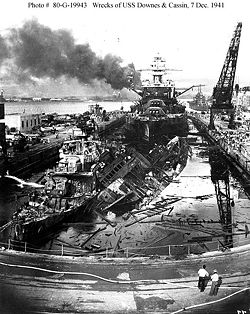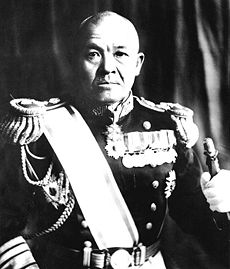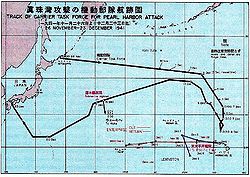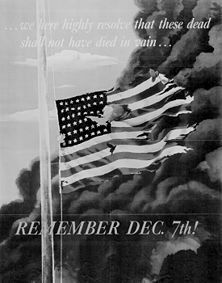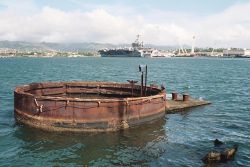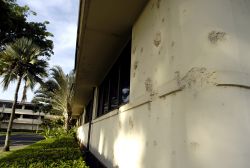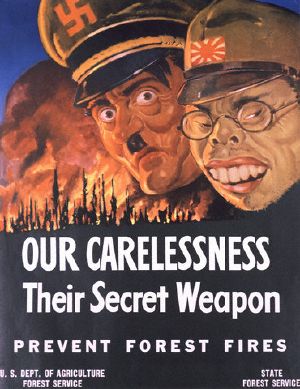Attack on Pearl Harbor
| ||||||||||||||||||||||||||||||||
| ||||||||||||||||||||||||||||||||
| ||||||||||||||||||||||||||||||||
The attack on Pearl Harbor was a surprise military strike on the United States Pacific Fleet base at Pearl Harbor, Hawaii by the Empire of Japan's Imperial Japanese Navy, on the morning of Sunday, December 7, 1941. Two attack waves, totaling 350 aircraft were launched from six IJN aircraft carriers which destroyed two U.S. Navy battleships, one minelayer, two destroyers and 188 aircraft. U. S. personnel losses totaled 2,333 killed and 1,139 wounded. Damaged warships included three cruisers, a destroyer, and six battleships. Of those six, one was deliberately grounded and was later refloated and repaired. Two sank at their berths but were later repaired and both rejoined the fleet late in the war. Vital fuel storage, shipyards, and submarine facilities were not hit. Japanese losses were minimal at 29 aircraft and five midget submarines, with 65 Japanese servicemen killed or wounded.
The attack was one of the most important engagements of World War II. Occurring before a formal declaration of war, it shocked the American public out of isolationism. Roosevelt called December 7, 1941 "… a date which will live in infamy." The result of the attack led to America's entry into the war and the defeat of both Nazi Germany and Imperialistic Japan. Both would be democratized and rebuilt through the Marshall Plan.
Background to conflict
More than a decade's worth of events leading to the attack on Pearl Harbor occurred prior to the actual engagement. War between Japan and the United States had been a possibility that each nation's militaries planned for since the 1920s, though real tension did not begin until the 1931 invasion of Manchuria by Japan. Over the next decade, Japan expanded slowly into China, leading to all out war between the two in 1937. In 1940 Japan invaded French Indochina in an effort to embargo all imports into China, including war supplies purchased from the U.S. This move prompted an eventual American embargo on exporting oil to Japan, which in turn led the Japanese to execute an attack on Pearl Harbor, ensuring the U.S. fleet would be unable to interfere with their simultaneous invasion of the Dutch East Indies for its oil and other resources as part of the Greater East Asia Co-Prosperity Sphere Japan envisioned in the Pacific.
Preliminary planning for an attack had begun in very early 1941, initially by Isoroku Yamamoto. After much contention with Naval Headquarters, permission was finally given for full scale planning by early spring 1941. Over the next months, pilots were trained, equipment prepared. Despite the preparation, the actual order to attack was not given until December 1, after it was apparent all diplomacy would not resolve matters acceptably to the Japanese.
The strike's intent was to protect Imperial Japan's advance into Malaya and the Dutch East Indies—for their natural resources such as oil and rubber—by neutralizing the U.S. Pacific Fleet. Both the U.S. and Japan had long-standing contingency plans for war in the Pacific, developed during the 1930s as tension between the two countries steadily increased, focusing on the other's battleships. Japan's expansion into Manchuria and later French Indochina were greeted with increasing levels of embargoes and sanctions from the United States. In 1940, the U.S. halted further shipments of airplanes, parts, machine tools and aviation gas to Japan, which Japan interpreted as an unfriendly act.[1] America continued to export oil to Japan, as it was understood in Washington that cutting off exports could mean Japanese retaliation. In the summer of 1941, the US ceased the export of oil to Japan due to Japan's continued aggressive expansionist policy and because an anticipated eventual American entrance to the war in Europe prompted increased stockpiling and less commercial use of gasoline. President Franklin D. Roosevelt had moved the fleet to Hawaii, and ordered a buildup in the Philippines, to reduce Japanese aggression in China and deter operations against others, including European colonies in Asia. The Japanese high command was certain any attack on the United Kingdom's colonies would inevitably bring the U.S. into the war.[2] The surprise attack on Pearl Harbor was intended to deter U.S. interference in the Pacific.
Approach and attack
First wave
The first attack wave consisted of 49 B5Ns, 51 D3As, 40 B5Ns, and 43 A6Ms (a total of 183 aircraft), launched north of Oahu, commanded by Captain Mitsuo Fuchida. It comprised:
- 1st Group
- 50 Nakajima B5Ns armed with 800 kg (1760 lb) armor piercing bombs, in four sections.
- 40 B5Ns armed with Type 91 torpedoes, also in four sections.
- 2nd Group - 55 Aichi D3As armed with 550 lb (249 kg) general purpose bombs
- 27 D3As - Hangars and aircraft on Ford Island
- 27 D3As - Hangars and aircraft on Wheeler Field
- 3rd Group - 45 A6Ms for air control and strafing, divided into three sections:
- 18 A6Ms - Ford Island and Hickam Field
- 15 A6Ms - Wheeler Field and Barbers Point
- 12 A6M - Kāneʻohe Marine Corps Air Station
The first attack wave divided into 3 groups. One unit went to Wheeler Field. Each of the aerial waves started with the bombers and ended with the fighters to deter pursuit.
At 03.42 Hawaiian Time, even before Nagumo began launching, the minesweeper USS Condor spotted a midget submarine outside the harbor entrance and alerted destroyer USS Ward. Ward carried out an unsuccessful search. The first shots fired, and the first casualties in the attack, occurred when USS Ward eventually attacked and sank a midget submarine, possibly the same one, at 06:37.
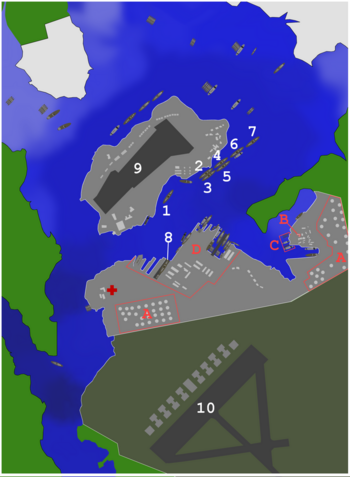
1:USS California 2:USS Maryland 3:USS Oklahoma 4:USS Tennessee
5:USS West Virginia 6:USS Arizona 7:USS Nevada 8:USS Pennsylvania 9:Ford Island NAS 10:Hickam field
Ignored:
A:Oil storage tanks B:CINCPAC C:Submarine base D:Naval yard
Five midget submarines had been assigned to torpedo U.S. ships after the bombing started. None of these returned, and only four have since been found. Of the ten sailors aboard, nine died; the only survivor, Kazuo Sakamaki, was captured, becoming the first Japanese prisoner of war.[3]
On the morning of the attack, the Army's Opana Point station (an SCR-270 radar, located near the northern tip of Oahu, which had been in training mode for months and had not entered official service), detected the first wave of Japanese planes and called in a warning. Although the operators at Opana Point reported a target echo larger than anything they had ever seen, an untrained new officer at the new and only partially activated Intercept Center, Lieutenant Kermit A. Tyler, presumed the scheduled arrival of six B-17 bombers was the cause because of the direction from which the aircraft were coming (only a few degrees separated the two inbound courses); because he presumed the operators had never seen a formation as large as the U.S. bombers' on radar; and possibly because the operators had only seen the lead element of the incoming attack.[4]
Several U.S. aircraft were shot down as the first wave approached land; one at least radioed a somewhat incoherent warning. Other warnings from ships off the harbor entrance were still being processed, or awaiting confirmation, when the planes began bombing and strafing. Nevertheless, it is not clear any warnings would have had much effect even had they been interpreted correctly and much more promptly. The results the Japanese achieved in the Philippines were essentially the same as at Pearl Harbor, though MacArthur had almost nine hours warning the Japanese had attacked at Pearl (and specific orders to commence operations) before they actually struck his command.
The air portion of the attack on Pearl Harbor began at 7:48A.M. December 7 Hawaiian Time (3:18A.M. December 8 Japanese Standard Time, as kept by ships of the Kido Butai), with the attack on Kaneohe.[4] Japanese planes attacked in two waves; a total of 353 planes reached Oʻahu. Slow, vulnerable torpedo bombers led the first wave, exploiting the first moments of surprise to attack the most important ships present (the battleships), while dive bombers attacked U.S. air bases across Oʻahu, starting with Hickam Field, the largest, and Wheeler Field, the main AAC fighter base. The 170 planes in the second wave attacked the Air Corps' Bellows Field near Kaneohe on the windward side of the island, and Ford Island. The only significant air opposition came from a handful of P-36 Hawks and P-40 Warhawks that flew 25 sorties.
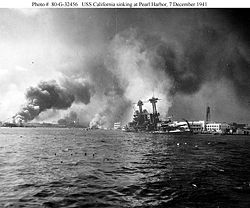
Men aboard U.S. ships awoke to the sounds of bombs exploding and cries of "Away fire and rescue party" and "All hands on deck, we're being bombed" and other various calls to General Quarters. The famous message, "Air raid Pearl Harbor. This is not drill.," was sent from the headquarters of Patrol Wing Two, the first senior level Hawaiian command to respond.[5] Despite a lack of readiness, which included locked ammunition lockers, aircraft parked wingtip to wingtip to prevent sabotage, and no heightened alert status, and on at least one battleship, all watertight doors open throughout the ship in preparation for an inspection, many American military personnel served with distinction during the battle. Rear Admiral Isaac C. Kidd, and Captain Franklin Van Valkenburgh, commander of USS Arizona, both rushed to the bridge to direct her defense, until both were killed by an explosion in the forward magazine from an armor piercing bomb hit next to turret two. Both were posthumously awarded the Medal of Honor. Ensign Joe Taussig got his ship, USS Nevada, underway from a dead cold start during the attack. One of the destroyers, USS Aylwin, got underway with only four officers aboard, all Ensigns, none with more than a year's sea duty. That ship operated at sea for four days before her commanding officer managed to get aboard. Captain Mervyn Bennion, commanding USS West Virginia (Kimmel's flagship), led his men until he was cut down by fragments from a bomb hit in USS Tennessee, moored alongside.
Gallantry was widespread. In all, 14 officers and sailors were awarded the Medal of Honor. A special military award, the Pearl Harbor Commemorative Medal, was later authorized for all military veterans of the attack.
Second wave composition
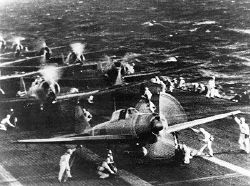
The second wave consisted of 54 B5Ns, 78 D3As, and 35 A6Ms (a total of 167), launched from much the same location, commanded by Lieutenant-Commander Shigekazu Shimazaki. This wave and its targets comprised:
- 1st Group - 54 B5Ns armed with general purpose bombs
- 27 B5Ns - Aircraft and hangars on Kaneohe, Ford Island and Barbers Point
- 27 B5N - Hangars and aircraft on Hickam Field
- 2nd Group
- 78 D3As armed with general purpose bombs, in four sections
- 3rd Group - 36 A6Ms for defense and strafing
- 9 A6M - Ford Island
- 9 A6M - Hickam Field
- 9 A6M - Wheeler Field
- 9 A6M - MCAS Kāneʻohe
The second wave was divided into three groups. One unit was tasked to attack Kāneʻohe, the rest Pearl Harbor proper. The separate sections arrived at the attack point almost simultaneously, from several directions.
Ninety minutes after it began, the attack was over; 2,386 Americans died (55 were civilians, most killed by unexploded American anti-aircraft shells landing in civilian areas), a further 1,139 wounded. Eighteen ships were sunk, including five battleships.
Nearly half of the 1102 American fatalities were caused by the explosion and sinking of USS Arizona, the result of her forward magazine exploding after it was hit by a modified 40 cm (16in) shell.
USS Nevada attempted to exit the harbor, but was deliberately beached to avoid blocking the harbor entrance. Already damaged by a torpedo and on fire forward, Nevada was targeted by many Japanese bombers as she got underway, sustaining more hits from 250 lb (113 kg) bombs as she beached.
USS California was hit by two bombs and two torpedoes. The crew might have kept her afloat, but were ordered to abandon ship just as they were raising power for the pumps. Burning oil from Arizona and West Virginia drifted down on her, and probably made the situation look worse than it was. The disarmed target ship USS Utah was holed twice by torpedoes. USS West Virginia was hit by seven torpedoes, the seventh tearing away her rudder. USS Oklahoma was hit by four torpedoes, the last two above her belt armor, which caused her to capsize. USS Maryland was hit by two of the converted 40 cm shells, but neither caused serious damage.
Although the Japanese concentrated on battleships (the largest vessels present), they did not ignore other targets. The light cruiser USS Helena was torpedoed, and the concussion from the blast capsized the neighboring minelayer USS Oglala. Two destroyers in dry dock were destroyed when bombs penetrated their fuel bunkers. The leaking fuel caught fire, flooding the dry dock in an effort to fight fire made the burning oil rise, and so the ships were burned out. The light cruiser USS Raleigh was holed by a torpedo. The light cruiser USS Honolulu was damaged but remained in service. The destroyer USS Cassin capsized, and destroyer USS Downes was heavily damaged. The repair vessel USS Vestal, moored alongside Arizona, was heavily damaged and beached. The seaplane tender USS Curtiss was also damaged. USS Shaw was badly damaged when two bombs penetrated her forward magazine.
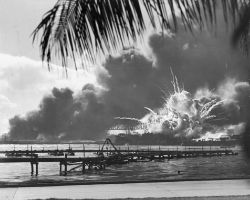
Almost all of the 188 American aircraft in Hawaii were destroyed or damaged, 155 of those on the ground. Almost none were actually ready to take off to defend the base, having been parked wingtip to wingtip as a sabotage protection measure. Of 33 PBYs in Hawaii, 24 were destroyed, and six others damaged beyond repair. (The three on patrol returned undamaged.) Attacks on barracks killed additional personnel. Friendly fire brought down several U.S. planes, including some from an inbound flight from USS Enterprise.
Fifty-five Japanese airmen and nine submariners were killed in the action. Of Japan's 387[6] available planes (350 took part in the attack), 29 were lost during the battle (nine in the first attack wave, 20 in the second) with another 74 damaged by antiaircraft fire from the ground.
Possible third wave
Several Japanese junior officers, including Fuchida and Genda, urged Admiral Nagumo to carry out a third strike in order to destroy as much of Pearl Harbor's fuel storage, maintenance, and dry dock facilities as possible.[7] Some military historians have suggested the destruction of these oil tanks and repair facilities would have crippled the U.S. Pacific Fleet far more seriously than did loss of its battleships. If they had been wiped out, "serious [American] operations in the Pacific would have been postponed for more than a year."[8] Nagumo, however, decided to forgo a third attack in favor of withdrawal for several reasons:
- American anti-aircraft performance had improved considerably during the second strike, and two-thirds of Japan's losses were incurred during the second wave (20 out of 29 lost planes).[9] Nagumo felt if he launched a third strike, he would be risking three-quarters of the Combined Fleet's strength to wipe out the remaining targets (which included the port facilities) while suffering higher aircraft losses.[9]
- The location of the American carriers remained unknown to Nagumo. In addition, the Admiral was concerned his force was now within range of American land-based bombers. Nagumo was uncertain whether the U.S. had enough surviving planes remaining on Hawaii to launch an attack against Japan's carriers.[9]
- A third wave attack would have required substantial preparation and turn-around time, and would have meant returning planes would have faced night landings. At the time, no Navy had developed night carrier techniques, so this was a substantial risk.
- The task force's fuel situation did not permit him to remain in waters north of Pearl Harbor much longer since he was at the very limits of logistical support. To do so risked running unacceptably low on fuel, perhaps even having to abandon destroyers en route home.[4]
- He believed the second strike had essentially satisfied the main objective of his mission—the neutralization of the Pacific Fleet—and did not wish to risk further losses.[8]
At a conference aboard Yamato the following morning, Yamamoto initially supported Nagumo's decision to withdraw.[8] In retrospect, however, Nagumo's decision to spare the vital dockyards, maintenance shops, and oil depots meant the U.S. could respond relatively quickly to Japanese activities in the Pacific. Yamamoto later regretted Nagumo's decision and categorically stated it had been a great mistake not to order a third strike.[8]
Aftermath
American response
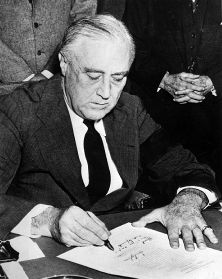
On December 8, 1941, Roosevelt addressed a joint session of Congress, calling December 7, 1941 "a date which will live in infamy." Amid outrage at the attack and the late delivery of the note breaking off relations, actions considered treacherous, Congress declared war on Japan with Jeannette Rankin (Republican of Montana) casting the only dissenting vote. Roosevelt signed the declaration the same day. Continuing to intensify its military mobilization, the U.S. government finished converting to a war economy, a process begun by provision of weapons to the Soviet Union and Great Britain.
The Pearl Harbor attack immediately galvanized a divided nation into action. Public opinion had been moving towards support for entering the war during 1941, but considerable opposition remained until the Pearl Harbor attack. Overnight, Americans united against Japan, and probably made possible the unconditional surrender position later taken by the Allied Powers. Some historians believe the attack on Pearl Harbor doomed Japan to defeat simply because it awakened the "sleeping beast," regardless of whether the fuel depots or machine shops had been destroyed or even if the carriers had been caught in port and sunk. U.S. industrial and military capacity, once mobilized, was able to pour overwhelming resources into both the Pacific and Atlantic theaters. Others believe Japanese trade protection was so incompetent, U.S. submarines could have strangled Japan into defeat alone.
Perceptions of treachery in the attack before a declaration of war sparked fears of sabotage or espionage by Japanese sympathizers residing in the U.S., including citizens of Japanese descent and was a factor in the subsequent Japanese internment in the western United States. Other factors included misrepresentations of intelligence information (none) suggesting sabotage, notably by General John DeWitt, commanding Coast Defense on the Pacific Coast, who had personal feelings against Japanese Americans.[10] In February 1942, Roosevelt signed United States Executive Order 9066, requiring all Japanese Americans to submit themselves for an internment.
Germany declares war
Nazi Germany and Fascist Italy declared war on the United States on December 11, allowing the US to formally enter the war in Europe. Adolf Hitler and Benito Mussolini were under no obligation to declare war under the mutual defense terms of the Tripartite Pact. However, relations between the European Axis Powers and the United States had deteriorated since 1937. Earlier in 1941, the Nazis learned of the U.S. military's contingency planning to get troops in Continental Europe by 1943; this was Rainbow Five, made public by sources unsympathetic to Roosevelt's New Deal, and published by the Chicago Tribune. Hitler decided war with the United States was unavoidable, and the Pearl Harbor attack, the publication of Rainbow Five, and Roosevelt's post-Pearl Harbor address, which focused on European affairs as well as the situation with Japan, probably contributed to the declaration. Hitler underestimated American military production capacity, the nation's ability to fight on two fronts, and the time his own Operation BARBAROSSA would require. Similarly, the Nazis may have hoped the declaration of war, a showing of solidarity with Japan, would result in closer collaboration with the Japanese in Eurasia, particularly against the Soviet Union. Regardless of Hitler's reasons, the decision was an enormous strategic blunder and allowed the United States to enter the European war in support of the United Kingdom and the Allies without much public opposition.
Hitler awarded Imperial Japanese ambassador to Nazi Germany Hiroshi Oshima the Grand Cross of the Order of the German Eagle in Gold (1st class) after the attack, praising Japan for striking hard and without first declaring war.[11]
Logistical and strategic analysis
The attack on Pearl Harbor failed to sight or destroy any of the Pacific Fleet's aircraft carriers; they had been, along with USN capital ships, primary targets.[12] The carriers Lexington and Enterprise were ferrying additional fighters to American bases on the islands of Wake and Midway.[13] At the time of the Japanese attack, the U.S. was expecting imminent war with Japan, beginning in any of several places, such as the Philippines or Allied bases in Borneo.[14] The attack at Pearl resulted in the permanent loss of USS Arizona and Oklahoma, and removed several other battleships (including Nevada, West Virginia, and California) from the battle line for months. However, all of these were older designs, too slow to serve as escorts for the carrier task forces which became central to the Pacific War, and so in practice, the most immediate consequences of the attack were the destruction of over 155 aircraft and shock to American pride.
Genda's plan and Nagumo's execution, left the shore installations at Pearl Harbor almost untouched, excluding aircraft hangars. The USS Arizona was sunk and beyond repair. Its hull underlies the Arizona Memorial. The Oklahoma capsized, was raised, stripped of guns and superstructure, sold for scrap and sunk under tow to San Francisco Bay in 1947. These were the only battleships lost that day. California, Tennessee, West Virginia, Maryland, Nevada, and Pennsylvania were repaired and would later exact some revenge on Japanese battleships during the Battle of Surigao Strait. Cruisers, essential to carrier task forces later in the war, had been considered tertiary targets and only three suffered damage. Of 27 destroyers present, only two were lost: Cassin, and Downes. (Even so, machinery, stores, and weapons were salvaged from all ships written off.)
Tank farms, containing 140 million gallons (530 million liters) of bunker oil, were unscathed providing a ready source of fuel for American submarines at the submarine base. Critical to the initial phase of the War and to commerce raiding throughout, these facilities would later illustrate the folly in Japanese planning. The Navy Yard, critical to ship maintenance, and repair of ships damaged in the attack was left undamaged. The engineering and initial repair shops, as well as the torpedo store, were intact. Other items of base infrastructure and operation such as the power station continued to operate. Also critical, the cryptanalysis unit, HYPO, located in the basement of the old Administration Building, was undamaged and actually benefited by gaining staff from unemployed ship's bands.[15]
The Army Air Force's loss of aircraft must be balanced against the fact that many of them were obsolete, such as the P-40's ancestor, the P-36. Japan might have achieved a good deal more with not much additional effort or loss.[16]
Nagumo's hesitation, and failure to find and destroy the American carriers, may have been a product of his lack of faith in the attack plan, and of the fact he was a gunnery officer, not an aviator. In addition, Yamamoto's targeting priorities, placing battleships first in importance, reflected an out-of-date Mahanian doctrine, and an inability to extrapolate from history, given the damage German submarines did to British trade in World War I. In the end, Japan achieved surprisingly little for all her daring and apparent success.[2]
The politics of a "Europe First" strategy, loss of air cover over Pearl Harbor, and subsequent loss of the Philippines, meant the U.S. Army and Army Air Corps were unable to play a significant role in the Pacific War for several months. Japan was temporarily free of worries about the major rival Pacific naval power, which was at least part of what had been intended for the attack. Because Australian, New Zealand, Dutch and most British forces were already in Europe, Japan conquered Southeast Asia, the Southwest Pacific, and extended her reach far into the Indian Ocean, without significant interference. The various Japanese advances were a nearly complete tactical success.
In retrospect, the attack was a strategic disaster for Japan. It spurred the United States into a determination to fight to complete victory. The War resulted in the destruction of the Japanese armed forces, the Occupation of the Home Islands (a state never before achieved in Japan's history), and the loss of Okinawa and the Ryukyu Islands to the United States until 1972, while the Soviet Russian re-annexation of the Kurile islands and Sakhalin Island's southern part, and China's seizure of Formosa (Taiwan), and the loss of Korea have not been reversed to this day.
|
|
| |||||||||||||||||||||||||||||||||||||||||||||||||||||||||||||||
Investigations and blame
President Roosevelt appointed an investigating commission, headed by U.S. Supreme Court Justice Owen Roberts to report facts and findings with respect to the attack on Pearl Harbor. It was the first of many official investigations (nine in all). Both the Fleet commander, Rear Admiral Husband E. Kimmel, and the Army commander, Lieutenant General Walter Short (the Army had been responsible for air defense of Hawaii, including Pearl Harbor, and for general defense of the islands against hostile attack), were relieved of their commands shortly thereafter. They were accused of "dereliction of duty" by the Roberts Commission for not making reasonable defensive preparations. None of the investigations conducted during the War, nor the Congressional investigation afterward, provided enough reason to reverse those actions. The decisions of the Navy and War Departments to relieve both was controversial at the time and has remained so. However, neither was court-martialed as would normally have been the result of dereliction of duty. On May 25, 1999, the U.S. Senate voted to recommend both officers be exonerated on all charges, citing "denial to Hawaii commanders of vital intelligence available in Washington."
Japanese views
Although the Imperial Japanese government had made some effort to prepare their population for war via anti-U.S. propaganda, it appears most Japanese were surprised, apprehensive, and dismayed by the news they were now at war with the U.S., a country many Japanese admired. Nevertheless, the people at home and overseas thereafter generally accepted their government's account of the attack and supported the war effort until their nation's surrender in 1945.[18]
Japan's national leadership at the time appeared to have believed war between the U.S. and Japan had long been inevitable. In any case, Japanese-American relationships had already significantly deteriorated since Japan's invasion of China beginning in the early 1930s, of which the United States strongly disapproved. In 1942, Saburo Kurusu, former Japanese ambassador to the United States, gave an address in which he talked about the "historical inevitability of the war of Greater East Asia."[19] He said war had been a response to Washington's longstanding aggression toward Japan. For example, provocations against Japan included the San Francisco School incident, (the United States' racist policies on Japanese immigrants), Naval Limitations Treaty, other Unequal treaties, the Nine Power Pact, constant economic pressure against Japan, culminating in the "belligerent" scrap metal and oil embargo in 1941 by the United States and Allied countries to contain and/or reverse the actions of the Empire of Japan especially in IndoChina during her expansion of influence and interests throughout Asia. In light of Japan's dependence on imported oil, the trade embargoes were especially significant. These pressures directly influenced Japan to go into alliance with Germany and Italy through the Tripartite Pact. According to Kurusu, because of these reasons, the Allies had already provoked war with Japan long before the attack at Pearl Harbor, and the United States was already preparing for war with Japan. Kurusu also states the United States was also looking for world domination, beyond just Asia, with "sinister designs."[19] Some of this view seems to have been shared by Adolf Hitler, when he called it one of the reasons Germany declared war on the United States. He also had mentioned European imperialism toward Japan many years before. Therefore, according to Kurusu, Japan had no choice but to defend herself and so should rapidly continue to militarize, bring Germany and Italy closer as allies and militarily combat the United States, Britain, and the Netherlands.
Japan's leaders also saw herself as justified in her conduct, believing that they are building the Greater East Asia Co-Prosperity Sphere. They also explained Japan had done everything possible to alleviate tension between the two nations. The decision to attack, at least for public presentation, was reluctant and forced on Japan. Of the Pearl Harbor attack itself, Kurusu said it came in direct response to a virtual ultimatum from the U.S. government, the Hull note, and so the surprise attack was not treacherous. Since the Japanese-American relationship already had hit its lowest point, there was no alternative; in any case, had an acceptable settlement of differences been reached, the Carrier Striking Task Force could have been called back.
Perception of the attack today
Some Japanese today still feel they were compelled to fight because of threats to their national interests and an embargo imposed by the United States, the United Kingdom and the Netherlands. The most important embargo was on oil on which its Navy and much of the economy was dependent.[20] The Japan Times, an English-language newspaper owned by one of the major news organizations in Japan (Asahi Shimbun), ran numerous columns in the early 2000s echoing Kurusu's comments in reference to the Pearl Harbor attack.[21]
In putting the Pearl Harbor attack into context, Japanese writers repeatedly contrast the thousands of U.S. servicemen killed there with the hundreds of thousands of Japanese civilians killed in U.S. air attacks later in the War,[22] even without mentioning the 1945 atomic bombings of Hiroshima and Nagasaki by the United States.
However, in spite of the perceived inevitability of the war by many Japanese, many also believe the Pearl Harbor attack, although a tactical victory, was actually part of a seriously flawed strategy for engaging in war with the U.S. As one columnist eulogizes, "The Pearl Harbor attack was a brilliant tactic, but part of a strategy based on the belief that a spirit as firm as iron and as beautiful as cherry blossoms could overcome the materially wealthy United States. That strategy was flawed, and Japan's total defeat would follow."[23] In 1991, the Japanese Foreign Ministry released a statement saying Japan had intended to make a formal declaration of war to the United States at 1P.M. Washington time, 25 minutes before the attack at Pearl Harbor was scheduled to begin. This officially acknowledged something that had been publicly known for years. Diplomatic communications had been coordinated well in advance with the attack, but had failed delivery at the intended time. It appears the Japanese government was referring to the "14-part message," which did not actually break off negotiations, let alone declare war, but did officially raise the possibility of a break in relations. However, because of various delays, the Japanese ambassador was unable to make the declaration until well after the attack had begun.
Imperial Japanese military leaders appear to have had mixed feelings about the attack. Fleet Admiral Isoroku Yamamoto was unhappy about the botched timing of the breaking off of negotiations. He is rumored to have said, "I fear all we have done is awakened a sleeping giant and filled him with terrible resolve." Even though this quote is unsubstantiated, the phrase seems to describe his feelings about the situation. He is on record as having said, in the previous year, that "I can run wild for six months … after that, I have no expectation of success."[24]
The first Prime Minister of Japan during World War II, Hideki Tojo later wrote, "When reflecting upon it today, that the Pearl Harbor attack should have succeeded in achieving surprise seems a blessing from Heaven."
Yamamoto had said, regarding the imminent war with the United States, "Should hostilities once break out between Japan and the United States, it is not enough that we take Guam and the Philippines, nor even Hawaii and San Francisco. We would have to march into Washington and sign the treaty in the White House. I wonder if our politicians (who speak so lightly of a Japanese-American war) have confidence as to the outcome and are prepared to make the necessary sacrifices?"[25]
Impact
A common view is that the Japanese fell victim to victory disease because of the perceived ease of their first victories. It has also been stated by the Japanese military commanders and politicians who visited and lived in the United States, that their leadership (mostly military personnel) took the war with the United States relatively lightly. In addition to Yamamoto, Battle of Iwo Jima commander Tadamichi Kuribayashi's opinions expressed the views and concerns about the greater industrial power of the United States in comparison to Japan.
Despite the perception of this battle as a devastating blow to America, only three ships were permanently lost to the U.S. Navy. These were the battleships Arizona, Oklahoma, and the old battleship Utah (then used as a target ship); nevertheless, much usable material was salvaged from them, including the two aft main turrets from Arizona. Heavy casualties resulted from Arizona’s magazine exploding and the Oklahoma capsizing. Four ships sunk during the attack were later raised and returned to duty, including the battleships California, West Virginia and Nevada. California and West Virginia had an effective torpedo-defense system which held up remarkably well, despite the weight of fire they had to endure, resulting in most of their crews being saved. Many of the surviving battleships were heavily refitted, including the replacement of their outdated secondary battery of anti-surface 5 inch (127 mm) guns with more useful turreted dual-purpose (antiaircraft and antiship) guns, allowing them to better cope with the new tactical reality. In fact, their rate of fire was too low to deal with aircraft, as experience with kamikaze would demonstrate. Not until the introduction of a fully automatic 3 inch {76 mm} postwar was a suitable solution found. Addition of modern radar to the salvaged vessels would give them a marked qualitative advantage over those of the IJN, and the slow battleships (incapable of operating with carrier task forces, unlike the Iowas) would prove useful delivering pre-invasion bombardment for the island hopping offensive against the Japanese in the Pacific. Destroyers Cassin and Downes were total losses as ships, but their machinery was salvaged and fitted into new hulls, retaining their original names, while Shaw was raised and returned to service.
Of the 22 Japanese ships that took part in the attack, only one survived the war. As of 2006, the only U.S. ships in Pearl Harbor during the attack still remaining afloat are the Coast Guard Cutter Taney and the yard tug USS Hoga. Both remained active over 50 years after the attack and have been designated museum ships.
In the long term, the attack on Pearl Harbor was a strategic blunder for Japan. Indeed, Admiral Yamamoto, who conceived it, predicted that even success here could not win a war with the United States, because American productive capacity was too large. One of the main Japanese objectives was to destroy the three American aircraft carriers stationed in the Pacific, but they were not present: Enterprise was returning from Wake, Lexington from Midway, and Saratoga was under refit at Puget Sound Naval Shipyard. Putting most of the U.S. battleships out of commission was regarded—in both navies and by most military observers worldwide—as a tremendous success for Japan.
Though the attack was notable for its large-scale destruction, the attack was not significant for American fuel storage, maintenance and intelligence capabilities. Had Japan destroyed the American carriers, the U.S. would have sustained significant damage to the Pacific Fleet's ability to conduct offensive operations for a year or so (given no further diversions from the Atlantic Fleet). As it was, the elimination of the battleships left the U.S. Navy with no choice but to place its faith in aircraft carriers and submarines–the very weapons with which the U.S. Navy halted and eventually reversed the Japanese advance. A major flaw of Japanese strategic thinking was a belief the ultimate Pacific battle would be between battleships of both sides, in keeping with the doctrine of Captain Alfred Mahan. As a result, Yamamoto (and his successors) hoarded his battleships for a "decisive battle" that never happened.
Ultimately, targets not on Genda's list, such as the Submarine Base and the old Headquarters Building, were more important than any battleship. It was submarines that immobilized IJN's heavy ships and brought Japan's economy to a standstill by crippling transportation of oil and raw materials. And in the basement of the old Administration Building was the cryptanalytic unit, HYPO, which contributed significantly to the Midway ambush and the Submarine Force's success.
Rise of anti-Japanese sentiment and historical significance
The attack on Pearl Harbor coupled with Japanese alliance with the Nazis and the ensuing war in the Pacific fueled anti-Japanese sentiment, racism, xenophobia and anti-Axis sentiment in the Allied nations. It resulted in internment of Japanese, German and Italian populations in the United States and others, for instance the Japanese American internment and German American internment. It resulted in the United States fighting the Germans and Italians among others in Europe and Japan in the west. Japanese, Japanese-Americans and Asians having a similar physical appearance were regarded with deep seated suspicion, distrust and hostility. The attack was viewed as having been conducted in an extremely underhanded way, as a very "treacherous" or "sneaky attack."
The attack had history-altering consequences. Prime Minister Winston Churchill, on hearing of the attack, wrote, "Being saturated and satiated with emotion and sensation, I went to bed and slept the sleep of the saved and thankful."[26] By opening the Pacific War, which ended in the unconditional surrender of Japan, it broke the power of an Asian check on Soviet expansion. The Allied victory in this war and subsequent U.S. emergence as a dominant world power, eclipsing Britain, has shaped international politics ever since.
Pearl Harbor is generally regarded as an extraordinary event in American history, remembered as the first time since the War of 1812 America was attacked on its home soil by another country. While this assertion is technically erroneous, as Hawaii was not a state at the time, it was widely regarded as "home soil." It was the first decisive defeat for the United States in World War II. It has become synonymous with "surprise attack" ever since in the U.S.
Notes
- ↑ Peace and War United States Foreign Policy 1931-1941 Retrieved September 27, 2017.
- ↑ 2.0 2.1 David C. Evans and Mark R. Peattie, Kaigun: Strategy, Tactics, and Technology in the Imperial Japanese Navy, 1887-1941 (United States Naval Institute, 2008, ISBN 0870211927).
- ↑ Kazuo Sakamaki, I Attacked Pearl Harbor (Rollston Press, 2017, ISBN 978-0997074840).
- ↑ 4.0 4.1 4.2 Gordon W. Prange, At Dawn We Slept (McGraw-Hill, 1981, ISBN 978-0070506695).
- ↑ Air Raid on Pearl Harbor The Library of Congress, American Memory. Retrieved September 27, 2017.
- ↑ WW II Pacific, Dec 7, 1941 Aircraft at Pearl Harbor. ww2pacific.com. Retrieved September 27, 2017.
- ↑ Harry A. Gailey, The War in the Pacific From Pearl Harbor to Tokyo Bay (Novato, CA: Presidio, 1995, ISBN 978-0891414865), 68.
- ↑ 8.0 8.1 8.2 8.3 Gailey, 97-98.
- ↑ 9.0 9.1 9.2 Edwin P. Hoyt, Pearl Harbor (G.K. Hall & Co., 1991), 190-191.
- ↑ Korematsu v. United States Retrieved September 27, 2017.
- ↑ Trial transcripts at Nuremberg December 11, 1945. More details of the exchanges at the meeting are available online at The Nizkor Project. Retrieved September 27, 2017.
- ↑ Japanese Monograph Number 97 Pearl Harbor operation Prepared by Military History Section Headquarters, Army Forces Far East. ibiblio.org. Retrieved September 27, 2017.
- ↑ Richard Holmes, The World Atlas of Warfare: Military Innovations that Changed the Course of History (Viking, 1988), 211.
- ↑ War warning, dated 27 November 1941 Retrieved September 27, 2017. The involvement of numerous units of the Japanese Army and the apparent disposition of IJN forces suggested amphibious operations against either the Philippines Thai or the Kra Peninsula or possibly Borneo, which was the reason warning cables had been sent to all Pacific commands by both the Navy and War Departments at Washington.
- ↑ W. J. Holmes, Double-Edged Secrets: U.S. Naval Intelligence Operations in the Pacific During World War II (Naval Institute, 1979, ISBN 978-0870211621).
- ↑ Martin Caiden, Fork-Tailed Devil (Military History (Ibooks), 2001, ISBN 978-0743413183).
- ↑ Pearl Harbor Attack Hearings, Pt. 15, 1901-1906. ibiblio.org. Retrieved September 27, 2017.
- ↑ Robert Guillain, I saw Tokyo burning: An eyewitness narrative from Pearl Harbor to Hiroshima (J. Murray, 1981, ISBN 0719538629).
- ↑ 19.0 19.1 Saburo Kurusu, Historical inevitability of the war of Greater East Asia, Foreign Broadcast Intelligence Service, Tokyo, November 26, 1942. ibiblio.org. Retrieved September 27, 2017.
- ↑ Haruko Taya Cook and Theodore Failor Cook, Japan at War: An Oral History (New York, NY: New Press, 1992, ISBN 978-1565840140).
- ↑ Charles Burress, Biased history helps feed U.S. fascination with Pearl Harbor The Japan Times, July 19, 2001. Retrieved September 27, 2017.
- ↑ Hiroaki Sato, Debunking America's 'Good War' myth The Japan Times, June 25, 2001. Retrieved September 27, 2017.
- ↑ Burritt Sabin, Dawn of a tragic era The Japan Times, February 8, 2004. Retrieved September 27, 2017.
- ↑ Ronald H. Spector, Eagle against the Sun The American War with Japan (New York, NY: Free Press of Glencoe, 1984, ISBN 978-0029303603).
- ↑ Mini-biography of Isoroku Yamamoto. National Geographic.
- ↑ Winston Churchill, The Second World War, Vol. 3., 539.
ReferencesISBN links support NWE through referral fees
- Beach, Edward L. Scapegoats: A Defense of Kimmel and Short at Pearl Harbor. Naval Institute Press, 1995. ISBN 978-1557500595.
- Caiden, Martin. Fork-Tailed Devil. Military History (Ibooks), 2001. ISBN 978-0743413183
- Churchill, Winston S. The Second World War. Mariner Books, 1986. ISBN 978-0395416853.
- Clausen, Henry C., and Bruce Lee. Pearl Harbor: Final Judgment. New York: Crown, 1992. ISBN 9780517586440. an account of the secret "Clausen Inquiry" undertaken late in the war by order of Congress to Secretary of War Stimson.
- Cook, Haruko Taya, and Theodore Failor Cook. Japan at War: An Oral History. New York: New Press, 1992. ISBN 978-1565840140.
- Evans, David C., and Mark R. Peattie. Kaigun: Strategy, Tactics, and Technology in the Imperial Japanese Navy, 1887-1941. United States Naval Institute, 2008. ISBN 0870211927.
- Fish, Hamilton. Tragic Deception: FDR and America's Involvement in World War II. Devin-Adair Pub, 1983. ISBN 0815969171.
- Gailey,Harry A. The War in the Pacific From Pearl Harbor to Tokyo Bay. Novato, CA: Presidio, 1997. ISBN 978-0891414865.
- Gannon, Michael V. Pearl Harbor Betrayed. Henry Holt, 2001. ISBN 978-0805066982. a recent examination of the issues surrounding the surprise of the attack.
- Guillain, Robert. I saw Tokyo burning: An eyewitness narrative from Pearl Harbor to Hiroshima. J. Murray, 1981. ISBN 0719538629
- Holmes, Richard. The World Atlas of Warfare: Military Innovations that Changed the Course of History. Viking, 1988. ISBN 978-0670819676
- Holmes, W. J. Double-Edged Secrets: U.S. Naval Intelligence Operations in the Pacific During World War II. Naval Institute, 1979. ISBN 978-0870211621. contains some important material, such as Holmes' argument that, had the U.S. Navy been warned of the attack and put to sea, it would have likely resulted in an even greater disaster.
- Horn, Steve. The Second Attack on Pearl Harbor: Operation K And Other Japanese Attempts to Bomb America in World War II. Naval Institute Press, 2005. ISBN 1591143888.
- Hoyt, Edwin P. Pearl Harbor. G.K. Hall & Co., 2000. ISBN 978-0783893037.
- Hughes-Wilson, John. Military Intelligence Blunders and Cover-Ups. Robinson, 2004. ISBN 978-0786713738. Contains a brief but insightful chapter on the particular intelligence failures, and broader overview of what causes them.
- Kimmett, Larry, and Margaret Regis. The Attack on Pearl Harbor: An Illustrated History]. NavPublishing, 2004, ISBN 978-1879932043. Using maps, photos, unique illustrations, and an animated CD, this book provides a detailed overview of the surprise attack that brought the United States into World War II.
- Krepinevich, Andrew. Lighting the Path Ahead. Center for Strategic and Budgetary Assessments. Retrieved September 27, 2017. contains a passage regarding the Yarnell attack, as well as reference citations.
- Lord, Walter. Day of Infamy. Henry Holt, 2001. ISBN 978-0805068030. a very readable, and entirely anecdotal, re-telling of the day's events.
- Madsen, Daniel. Resurrection-Salvaging the Battle Fleet at Pearl Harbor. U.S. Naval Institute Press. 2003. ISBN 978-1557504883. Highly readable and thoroughly researched account of the aftermath of the attack and the salvage efforts from December 8, 1941 through early 1944.
- McCollum memo. Retrieved September 27, 2017. A 1940 memo from a Naval headquarters staff officer to his superiors outlining possible provocations to Japan, which might lead to war (declassified in 1994).
- Parker, Frederick D., Pearl Harbor Revisited: United States Navy Communications Intelligence 1924–1941. Center for Cryptologic History, 1994. ISBN 978-1478344292. contains a detailed description of what the Navy knew from intercepted and decrypted Japan's communications prior to Pearl.
- Prange, Gordon W. At Dawn We Slept. McGraw-Hill, 1981. ISBN 978-0070506695.
- Prange, Gordon W. Pearl Harbor: The Verdict of History. McGraw-Hill, 1986. ISBN 978-0140159097.
- Prange, Gordon W. December 7, 1941: The Day the Japanese Attacked Pearl Harbor. McGraw-Hill, 1988. ISBN 978-0070506824. Prange's monumental trilogy, written with collaborators Donald M. Goldstein and Katherine V. Dillon, is considered the authoritative work on the subject.
- Sakamaki, Kazuo. I Attacked Pearl Harbor. Rollston Press, 2017. ISBN 978-0997074840
- Seki, Eiji. Mrs Fergusons Tea-set, Japan and the Second World War. BRILL/Global Oriental, 2006. ISBN 978-1905246281.
- Spector, Ronald H. Eagle against the Sun The American War with Japan. New York: Free Press of Glencoe, 1984. ISBN 978-0029303603.
- Stinnett, Robert, Day of Deceit: The Truth About FDR and Pearl Harbor. Free Press, 2001. ISBN 978-0743201292. A study of the Freedom of Information Act documents that led Congress to direct clearance of Kimmel and Short.
- Theobald, Robert A., Final Secret of Pearl Harbor. Devin-Adair Pub, 1977. ISBN 978-0815955030. Foreword by Fleet Admiral William F. Halsey, Jr.
- Toland, John. Infamy: Pearl Harbor and Its Aftermath. Berkeley, 1991. ISBN 978-0425090404. an excellent account by a Pulitzer Prize winning author, though thought by some not to back up his claims as thoroughly as expected by academic conventions.
- Wedemeyer, Albert C.. Wedemeyer Reports Henry Holt Co, 1958. ISBN 0892750111.
- Wohlstetter, Roberta. Pearl Harbor: Warning and Decision. Stanford University Press: 1962. ISBN 978-0804705981. Regarded by many as the most important work in the attempt to understand the intelligence failure at Pearl Harbor. Her introduction and analysis of the concept of "noise" persists in understanding intelligence failures.
External links
All links retrieved August 21, 2023.
- Guarding The United States And Its Outposts Official U.S. Army history of Pearl Harbor
- Library of Congress: The day after
- Second World War - USA Declaration of War on Japan.
- Collection of extensive Japanese preparation military documents
- Pearl Harbor Attack Hearings Detailed reports from various investigations.
- Pearl Harbor Attack at HyperWar
|
Western Europe · Eastern Europe · China · Africa · Mediterranean · Asia and the Pacific · Atlantic | |||||
|
Major participants |
Timeline |
Aspects | |||
|
Principal co-belligerents in italics. |
Prelude 1939 1940 1941 1942 |
1943 1944 1945 • more military engagements Aftermath |
• Attacks on North America Civilian impact and atrocities | ||
| Allies | Axis | ||||
|
at war from 1937 entered 1939 entered 1940 |
entered 1941 entered 1942 entered 1943 entered 1944 • others |
at war from 1937 entered 1939 entered 1940 entered 1941 entered 1942 • others | |||
| Resistance movements Austria · Baltic1 · Czechoslovakia · Denmark · Ethiopia · France · Germany · Greece · Italy · Jewish · Netherlands · Norway · Poland · Thailand · USSR · Ukraine2 · Vietnam · Yugoslavia · others | |||||
|
1 Anti-Soviet. | |||||
Credits
New World Encyclopedia writers and editors rewrote and completed the Wikipedia article in accordance with New World Encyclopedia standards. This article abides by terms of the Creative Commons CC-by-sa 3.0 License (CC-by-sa), which may be used and disseminated with proper attribution. Credit is due under the terms of this license that can reference both the New World Encyclopedia contributors and the selfless volunteer contributors of the Wikimedia Foundation. To cite this article click here for a list of acceptable citing formats.The history of earlier contributions by wikipedians is accessible to researchers here:
The history of this article since it was imported to New World Encyclopedia:
Note: Some restrictions may apply to use of individual images which are separately licensed.
